
General John Charles Meyer was an American World War II flying ace, and later the commander-in-chief of the Strategic Air Command (SAC) and director of the Joint Strategic Target Planning Staff at Offutt Air Force Base, Nebraska. SAC was the United States' major nuclear deterrent force with bombers, tankers and reconnaissance aircraft, and intercontinental ballistic missiles. The Joint Strategic Target Planning Staff coordinated the nation's nuclear war plans and developed the Single Integrated Operations Plan.

The 306th Flying Training Group is a unit of the United States Air Force, assigned to Air Education and Training Command (AETC). The group is stationed at the United States Air Force Academy (USAFA) near Colorado Springs, Colorado.
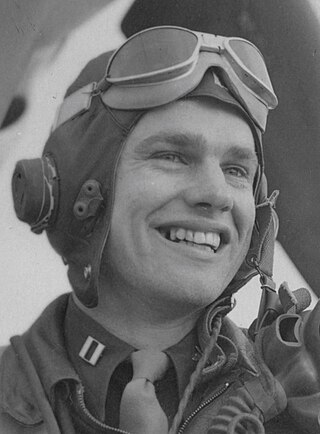
Clarence Emil "Bud" Anderson is a retired officer in the United States Air Force, a triple ace of World War II, and the highest scoring living American fighter ace. During the war he was the highest scoring flying ace in his P-51 Mustang squadron. Towards the end of Anderson's two combat tours in Europe in 1944 he was promoted to major at 22, a young age even for a highly effective officer in wartime. After the war Anderson became a well regarded fighter test pilot, and a fighter squadron and wing commander. He served his wing commander tour in combat in the Vietnam War. He retired as a full colonel in 1972, after which he worked in flight test management for McDonnell Douglas. A member of the National Aviation Hall of Fame, Anderson has remained a sought-after speaker at aviation and military events well into his 90s.

Ray Shuey Wetmore was a quadruple ace of United States Army Air Forces over Europe during World War II. He was credited with 21.25 victories in aerial combat. He was killed in an accidental crash of an F-86 at or near Otis Air Force Base.
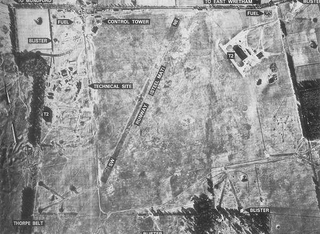
Royal Air Force East Wretham or more simply RAF East Wretham is a former Royal Air Force station located 6 miles (9.7 km) northeast of Thetford, Norfolk, England.

The 182d Fighter Squadron is a unit of the Texas Air National Guard 149th Fighter Wing located at Kelly Field Annex, Joint Base San Antonio, Texas. The 149th is equipped with the F-16C/D Fighting Falcon.

The 359th Fighter Group was a United States Army Air Force fighter unit that was active during World War II. Following organization and training in the United States, the group deployed to the European Theater of Operations, operating from RAF East Wretham. The fighter group flew 346 combat missions over continental Europe and claimed 373 enemy aircraft in aerial combat and strafing attacks; probable destruction of 23; and damage to 185. It was awarded the Distinguished Unit Citation for its actions. The group flew its last mission on 20 April 1945, then returned to the United States for inactivation.

The 181st Airlift Squadron is a unit of the 136th Airlift Wing of the Texas Air National Guard stationed at Naval Air Station Joint Reserve Base Fort Worth, Texas. The 181st is equipped with the Lockheed C-130J Hercules.
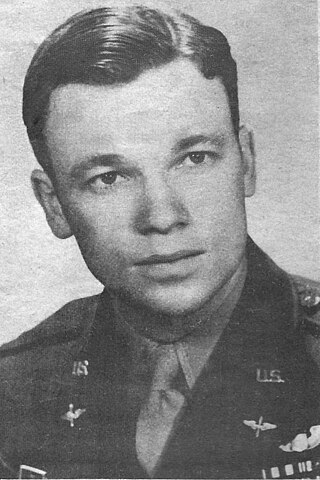
John Brooke England was a World War II fighter ace in the American 357th Fighter Group and a career fighter pilot in the United States Air Force.

The 359th Bombardment Squadron was a United States Air Force unit. It was last assigned to the 303d Bombardment Wing, stationed at Davis–Monthan Air Force Base, Arizona. It was inactivated on 15 June 1964.

Lieutenant General Winton Whittier Marshall was a United States Air Force general and flying ace. He was deputy commander in chief, U.S. Readiness Command, with headquarters at MacDill Air Force Base in Florida before retiring in 1977.

Gerald Richard Johnson was a World War II flying ace who flew for the United States Army Air Forces. Johnson commanded the 9th Fighter Squadron and 49th Fighter Group, and became the fourth ranking fighter ace in the Pacific during World War II. He ended his war career with 22 kills.

Glenn Todd Eagleston was a career officer in the United States Air Force and the leading ace of Ninth Air Force in Europe in World War II. Eagleston was credited with 18 1/2 victories, two probable victories, and seven damaged German aircraft. He also destroyed at least five enemy aircraft on the ground, while flying P-51 Mustangs with the 354th Fighter Group.
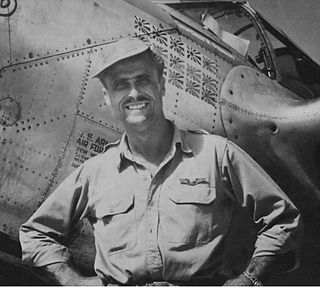
Robert Burdette Westbrook was a United States Army Air Forces lieutenant colonel and a World War II flying ace. Westbrook commanded the 44th Fighter Squadron, and became the leading fighter ace of the Thirteenth Air Force. He is also the ninth ranking fighter ace in the Pacific during World War II and also one of ten United States Army Air Forces pilots who became an ace in two different types of fighter aircraft.

Paul Page Douglas Jr was a brigadier general in the United States Air Force. During World War II, he flew the P-47 Thunderbolt in the European Theater of Operations and became one of the most highly decorated flying aces of the war. In 1968, he served as the commander of the 388th Tactical Fighter Wing and flew a full tour of bombing and fighter missions over North Vietnam. He retired from the Air Force on 1970.

William Douglas Dunham was an American flying ace in the 348th Fighter Group during World War II, scoring 16 aerial victories. He retired from the United States Air Force in 1970 at the rank of brigadier general.

Joseph Lennard Mason was a colonel in the United States Air Force. He commanded the 352nd Fighter Group during World War II and was a fighter ace. He later commanded the 3595th Pilot Training Wing and the 49th Fighter-Bomber Wing during the Korean War.
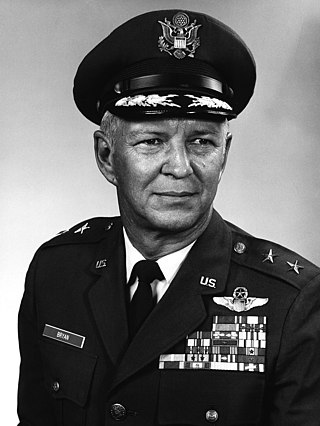
William Elmer Bryan Jr. was a United States Air Force Major General and a flying ace. Bryan flew combined total of 235 combat missions in World War II and Korean War, and was credited in destroying 7.5 enemy aircraft in aerial combat during World War II. He retired in 1974, after 33 years of distinguished service.

Willard Wesley Millikan was a United States Air Force Major General and a flying ace, who was credited in destroying 13 enemy aircraft in aerial combat during World War II. He retired in 1969, after 28 years of distinguished service.

Claude James Crenshaw was a United States Air Force lieutenant colonel and a flying ace, who was credited in destroying seven enemy aircraft in aerial combat during World War II.



























